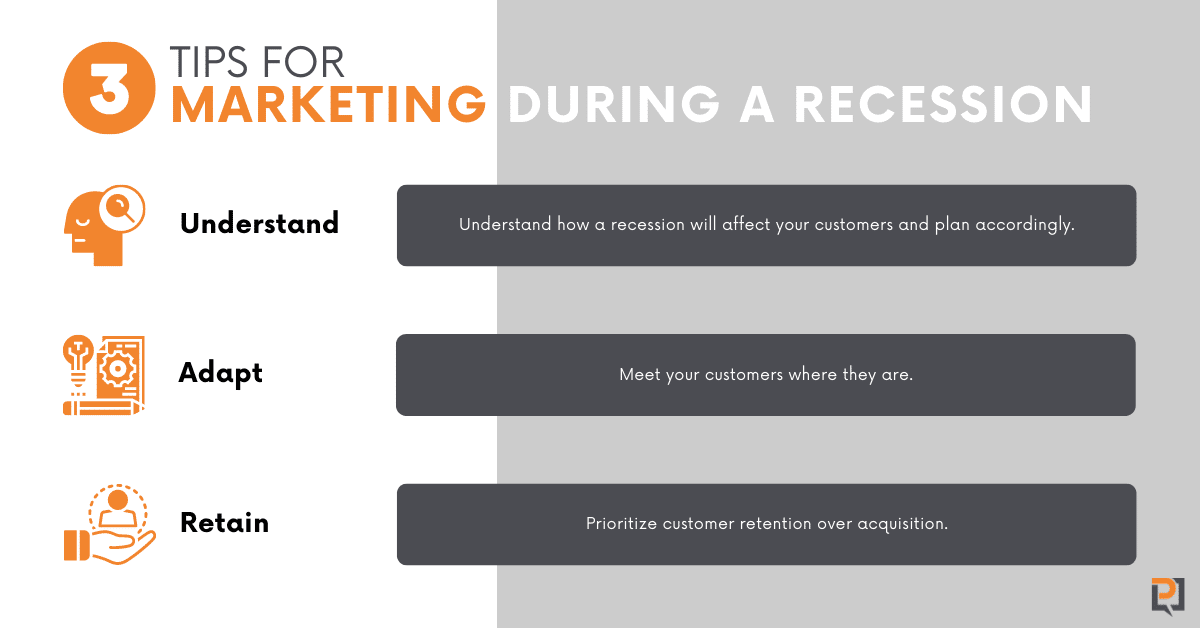3 Simple Tips for Marketing During a Recession
As the worst effects of the COVID-19 pandemic wane, marketing budgets are on the rise. But economic concerns are putting a damper on the return to pre-pandemic spending levels. Business leaders to proceed with caution as it appears likely that the US will experience a recession.
That doesn’t mean marketers should sit on their hands. Now is the time to determine how you will market your business during the coming recession.
Marketing Budgets Are Up – For Now
According to Gartner’s 2022 CMO Spend Survey, marketing budgets were on the rise at the time the survey was taken.
Almost three-quarters (72 percent) of CMOs said their budgets had increased from the previous year. Marketing budgets represented 9.5 percent of company revenue compared to 6.4 percent in 2021.
But rising interest rates, reduced consumer spending, and other factors indicate that a recession is on the horizon.

How to Market Your Business During a Recession
Of course, if the US economy does enter a recession marketers will still have a job to do. The question is how best to do it in the face of market uncertainty and a limited budget. Here are some tips to continue growing in a tough economy.
1. Understand How a Recession Will Affect Your Customers
John Quelch and Katherine E. Jocz say that four new customer segments arise during any economic downturn.
Recession Customer Segments
- Slam-on-the-Brakes. These customers are done spending until further notice. They will prioritize essentials. Anything else will be a tough sell.
- Pained-but-Patient. This segment is similar to the Slam-on-the-Brakes segment, but they tend to be more optimistic, so they are less stringent about cost-cutting.
- Comfortably Well-Off. These customers will spend less, but they won’t cut back drastically because they have the resources to weather the storm.
- Live-for-Today. These customers will largely go about their business as if there isn’t a recession.
These are consumer segments, but it’s easy to see how you can apply them to B2B marketing as well. According to Quelch and Jocz, each segment will categorize purchases as essentials, treats, postponables, or expendables.
Consumer Spending Priorities
- Essentials are must-haves.
- Treats are nice-to-haves that customers can justify purchasing right away.
- Postponables, whether they are must-haves or nice-to-haves, are purchases that can be delayed without dire consequences.
- Expendables are purchases that don’t make sense in the current economic climate.
While your product or service may have been an essential or a treat before the recession, it may be reprioritized as postponable or expendable when times are tough.
2. Meet Your Customers Where They Are
Work to understand where your ideal customers fall in the recession customer segments and where your product or service falls in their priorities. Then you can ensure they don’t irrationally discount the value you offer out of fear.
If they are, you will need to work even harder to demonstrate the benefits of your product or service.
If they’re right in their assessment of your offering, you’ll need to get creative to develop new offerings that are right for your customers. For example, can you offer a new, more affordable option? Or can you offer reasonable financing so that your customers don’t take the financial hit all at once?
3. Focus on Customer Retention
One of the most critical areas of focus during an economic downturn is customer retention. It’s estimated that acquiring a new customer costs anywhere from five to twenty-five times more than keeping an existing customer.
Fred Reichheld, the creator of the Net Promoter System, found that businesses that increase customer retention by 5% increase profits by at least 25% – and up to 95%!
But customer retention doesn’t get easier during tough times.
A 2022 survey found that 50 percent of customers will consider switching brands to save money during a recession. About 40 percent will stick with the same brand but purchase less frequently. Less than 15 percent said they would stay with the same brands at the same purchase volume.
Reichheld recommends increasing customer retention by realigning sales and marketing goals to prioritize the acquisition of loyal customers. Do that by tying commissions and bonuses to the acquisition of customers who stick around, and prioritizing marketing channels based on their ability to generate loyal customers.
Also, consider loyalty programs with rewards that will give your best customers a break while they’re trying to reduce costs.
Should You Advertise During a Recession?
People won’t buy from you if they’ve never heard of you. They won’t buy your latest product if they don’t know it exists. That doesn’t change during a recession.
In fact, businesses that continue to advertise during economic downturns are more likely to continue to grow or recover more quickly.
So advertising is still necessary, but you should focus on:
- Channels that generate customers with a low churn rate
- Campaigns that will improve customer retention
And make sure you’re getting the most bang for your buck by reevaluating your lead capture software and other tools. For example, you might consider using website visitor identification so that you’ll be able to convert more of your paid traffic into leads even if they don’t fill out a form.
So Where Should You Cut Costs?
Your marketing team probably won’t be able to keep doing exactly what they were doing before the recession. But where can they save money?
Here are three areas to consider when making budget cuts:
- Software. Do an audit of all your tools and make sure that they’re delivering value. This is especially important for larger teams because you may have tools that everyone assumes someone else is using when no one even remembers the password.
- Outsourcing. Outsourcing can be a good way to reduce costs, but if it’s not absolutely necessary, you’re better off handling what you can in-house during a recession.
- Recruitment. This probably goes without saying, but it’s probably not a good idea to bring on new hires during a recession unless they’re replacing someone in a critical role.
Don’t Get Scared Now
Now is not the time for trepidation! Hope for the best, but prepare for the worst by taking steps to improve customer retention and acquire new customers more affordably. If you plan ahead and develop a roadmap for capitalizing on the opportunities that will arise during the coming recession, your business will continue to grow.

